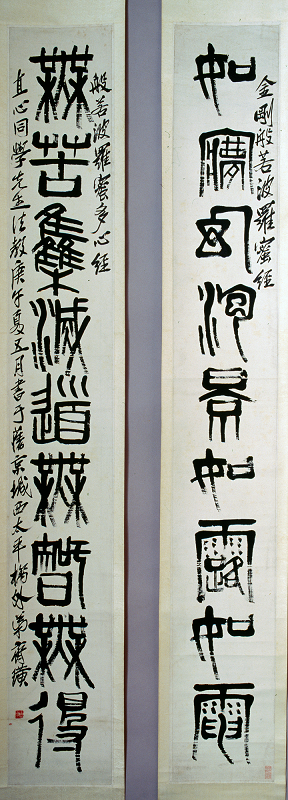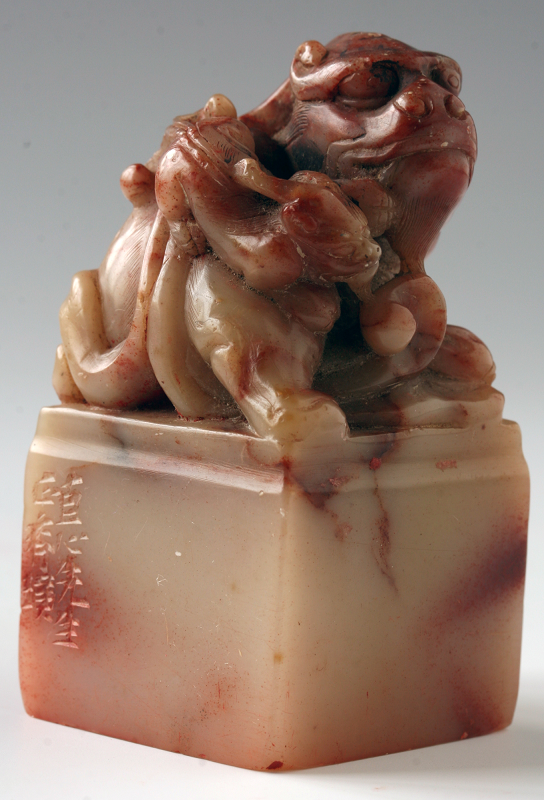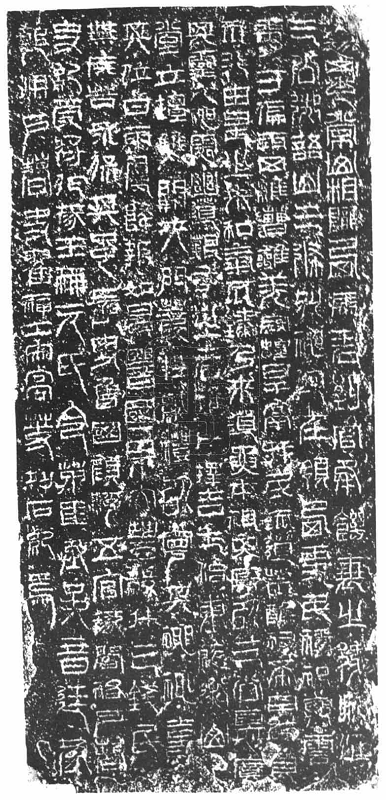A nine-character couplet in seal script by Qi Baishi

Paper
Vertical length: 175.2cm
Horizontal length: 23.8cm
The first line of the couplet on a scroll: “All conditioned occurrences are like a dream, a bubble, a shadow or like the morning dew, or like lightning” (from The Diamond Sutra)
The second line of the couplet: “There is No Truth of the Cessation of Suffering, nor of the Path. There is No Wisdom, and there is No Attainment Whatsoever.”(from The Heart Sutra)
It is inscribed with the following information: “enlightened by my classmate & instructor Xia Shoutian at the Old West Peace Bridge in Beijing in May, 1930. Yours: Qi Baishi”.
It is sealed in white with the seal of “Baishi the greybeard”
The couplet was created in 1930 when Qi Baishi was at the age of 68. The Old West Peace Bridge in Beijing refers to the dwelling place in Kuache Hutong (small alley) purchased by Qi Baishi in 1926. Before this purchase, Qi Baishi led 7 years of unstable life by renting houses here and there, even turning to ancient temples in Beijing for survival.
The major characters are written in seal script (a style of Chinese calligraphy, often used on seals)while the small inscriptions are in running handwriting. His acclaimed vigorous and bold freehand brushwork style in painting and unique seal engraving form are closely related to his art of calligraphy. He specializes in running handwriting and seal script. The couplet fully demonstrates his exploration into the art of calligraphy at the middle period of his art career.
The content of the couplet originates from classical Buddhist Scriptures.
深入探索
About the work
Qi Bishi created this artwork at the age of 68. Before this creation, he had already been copying from the “Stone Tablet from Sisangong Mountain” for a while. This tablet was created during the Eastern Han Dynasty, when the seal character had developed into maturity. Therefore, it resembled both the seal script and the official script [an ancient style of calligraphy in the Han Dynasty (206 B.C.-A.D.220)]. It reflected a sense of toughness, hardness and unsophisticatedness. The characters in this couplet employed the same structural style as that of the stone tablet. One would get the general impression that they were not so grandeur as the very vertical or horizontal lines of the characters written during the Qin Dynasty. However, they still embodied the beauty of simplicity and sincerity.
The small inscriptions in running script reflected the personal character of the creator. At his early years, Qi Baishi learned from He Shaoji and later at the age of 47 or 48, he turned to learn from Li Yong, especially copying his “The Stone Tablet Created of Yunhui General”. The running script by Li Yong was very unusual, looking lean and presenting a sense of steepness. Viewing from this couplet, it can be concluded that the running script by Qi Baishi is thicker than that by Li Yong. Qi’s style shows more natural grace, sincerity and vividness, which constituted his own unique style of the running script.



“The Stone Tablet from Sisangong Mountain”, a complete tablet collected by the National Library of China

The excerpt from “The Stone Tablet Created of Yunhui General”



